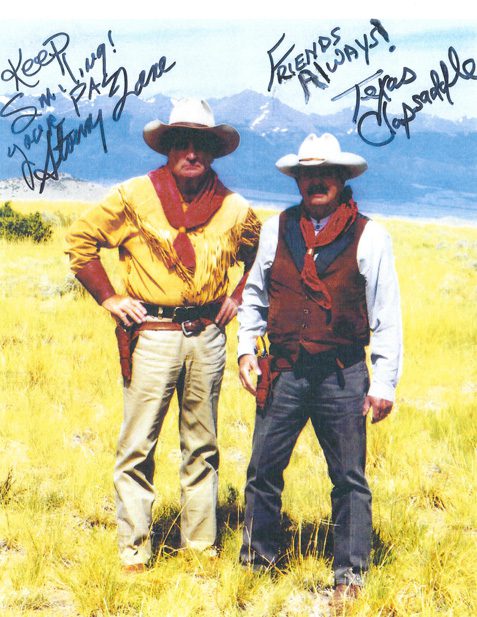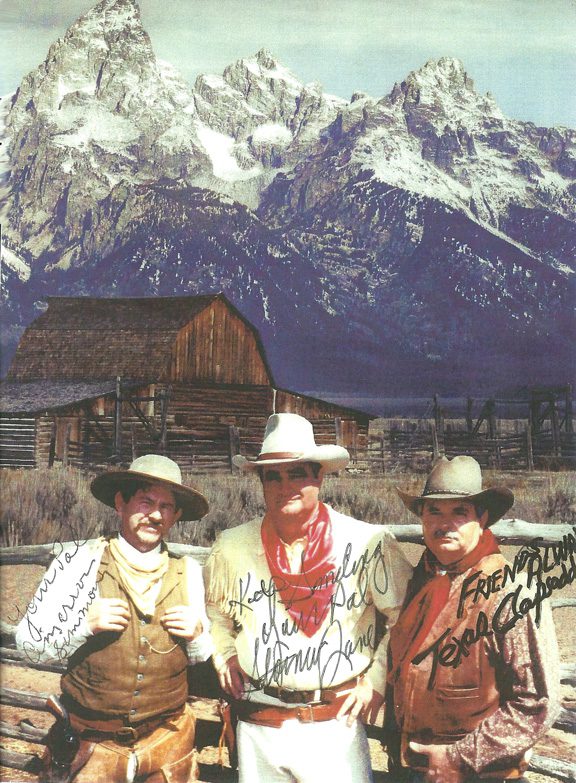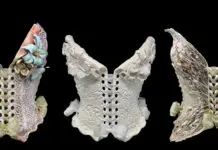
Photo courtesy Simon Hurst 2014.
[dropcap]Canyon[/dropcap] Trail may be the last film from brothers Rick and Larry Simpson, now deep into their 60s. If it is, Oklahoma will lose a component of the state’s home-grown film industry that has produced five westerns, each of which has shown a profit.
With no background in film or acting training, the two Enid brothers have scripted, filmed and marketed The Trail to Abilene, Guns Along The Bravo, Showdown at Devil’s Butte, Curse of the Sacred Mountain and Cactus Creek from 1999 to 2009. The westerns follow the adventures of Stormy Lane (Rick), Texas Clapsaddle (Larry) and Cimarron Simmons (trick rope artist Tom Ward) as they dispatch bad guys and rescue those in need.
The past several months they have been working on the latest western, Canyon Trail, filming scenes in Enid, Okla., Wichita, Kan., La Junta, Colo., and Chama, N.M. The Enid scenes are interiors shot in what had been the Simpsons’ western wear store, now partially a museum, and partially a film set.
“The hardest part for us now is scheduling when you’re dealing with people with real jobs,” says 69-year-old Larry Simpson. “Plus, we have to fight the weather. Two weather days forced us to cancel some of the shoots we were trying to do in Wichita.”
Canyon Trail has 70 speaking roles, along with 150 extras, as well as livestock. It includes the use of the historical Bent’s Fort and the steam locomotive belonging to the Cumbres and Toltec Railroad out of New Mexico.
The film also has Gunsmoke’s Buck Taylor, country singer R.W. Hamptom, Bryanna Holt (daughter of veteran actor Tim Holt), Wyatt McCrea (grandson of film star Joel McCrea) and World Champion National Cowboy Mounted Shooter Kenda Lenseigne.
“They’re going to put a second car on the train for us,” says 64-year-old Rick, with a smile while speaking of filming on the Cumbres and Toltec Railroad.
Having formed Skeleton Creek Productions – named for a creek on the east side of Enid by their homes – the brothers built their westerns around the Saturday matinee serial westerns of their childhood.
“In the old movies, you were either a good guy or a bad guy,” says Rick, who resembles Tom Mix once he is outfitted in movie garb. “Today, there are no heroes for kids to look up to who won’t let them down. In those old movies, men never swore, they always protected the kids and the womenfolk and drank sarsaparilla.”
Rick says their westerns have enjoyed surprising success because people want to go back to right versus wrong.
It is the determination to adhere to the old Cowboy Code throughout five movies that has drawn actors, the loan of livestock, offers of locations and volunteers doing everything from serving as extras to working construction for the set building.
“I jumped at the chance to work on their movies because it reminds me of my time on Gunsmoke,” says Buck Taylor.
The films have all made money, and the time it takes for each to clear a profit has shortened with each production.

“Publicity is a big deal as you are filming,” Rick says. “As for filming, we’ve learned to shoot less expensively.”
The brothers marketed their first two films through ads in the back of catalogs, out of their Enid store and out of western outfitter retail stores. Years would go by before a profit was realized.
Then in 2003, they marketed their third film, Showdown at Devil’s Butte, in eastern Europe. American cowboy movies are very popular in Poland. Sales skyrocketed.
Their love for the West and for westerns came from their father, K.P. Simpson. K.P. had been bitten by the acting bug years before the brothers were born. Their father even traveled to Hollywood, sneaking onto film lots. Back in Enid, to advertise their western wear store, K.P. wrote and filmed a series of comical TV ads featuring him as an old prospector looking for a good pair of jeans. They became the talk of the town.
K.P. decided he would take a shot at a real television program. People shopping in their store could hear the clacking of typewriter keys from the second floor office as K.P. hammered out research notes and short scripts. He then badgered NBC’s Unsolved Mysteries to give them a read. Executives of the program finally decided to film the episodes K.P. had researched. For payment, the elder Simpson asked for bit roles for himself and work on the set for his sons.
K.P. was the one who brought to the public the mysterious construction of the spiral staircase in Santa Fe, the possibility that Billy the Kid had lived on as Texas’ Brushy Bill, and the kidnapping of 4-year-old Joan Croft during the 1947 Woodward tornado. For payment, K.P. would play the carpenter building the staircase, or Brushy Bill, or the doctor in the Woodward tornado episode.

The Simpson brothers were gophers on the set, hammering props, fetching coffee and bringing in snacks for the crew – all the time watching and listening.
Their disgust in what had happened to the western led them to make their first film on a shoestring budget using volunteers. It was called The Trail to Abilene. Once done, they came across the same problem other independent film makers have: Now that you made it, what are you going to do with it?
In 1999, Hollywood was running away from the western as fast as it could. The only outlet the brothers could find for their project was in selling DVDs out of their father’s store. Rick took out ads in western magazines to sell the film. Two years later, sales finally covered the cost of production.
Most people would have thrown their hands up in exasperation, but not the Simpsons. They typed out a script for their second western, Guns Along the Bravo. They spread the word throughout northwest Oklahoma that they were looking for volunteers for their western but they couldn’t pay.
“The response was phenomenal,” says Larry. Within a few short weeks, they had their cast, prop men and locations. The film turned a profit, this time in 18 months rather than the 24 months the first film took.
“The summers in Oklahoma were so hot, we had to wait for things to cool down before we could film, and that’s hard when you’re dealing with cast members who have other commitments,” he continues.
The brothers were ready to sink some serious money into their next film, Showdown at Devil’s Butte. Cast was paid this time, as were the technical support and location set ups. And this third western was marketed for the first time in Europe.
Devil’s Butte got Hollywood’s attention. Old-time television actors called the brothers to ask about their next project. Buck Taylor and Laredo’s Peter Brown flew to Oklahoma to act in the next production. The movie also created the Stormy Lane Fan Club.
“We had some grandparents visiting our store one day purchasing Devil’s Butte, and they suggest we ought to start a fan club,” Rick says.
Now made up of children between the ages of 3 and 9, the fan club has more than 2,300 members in 37 states. For a $6 annual fee, children receive a certificate, a fake bullet or arrowhead and a copy of the Code of the West to live by.
“We had one member who was 93 years old,” Simpson says.
Canyon Trail is set to premiere in Enid Nov. 9.

























